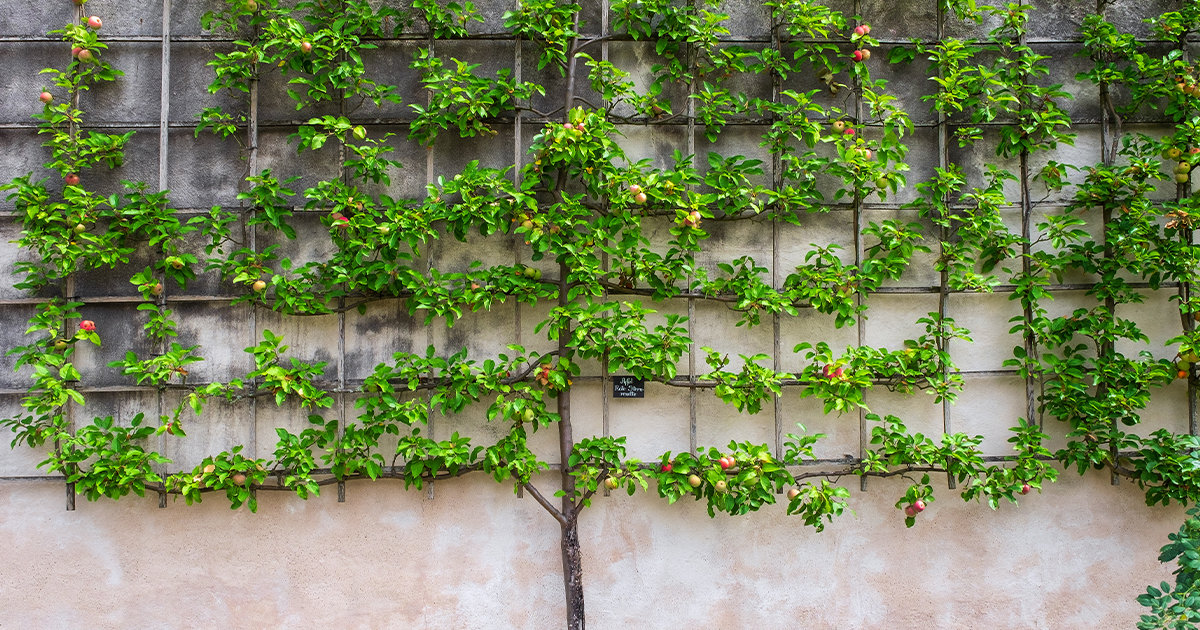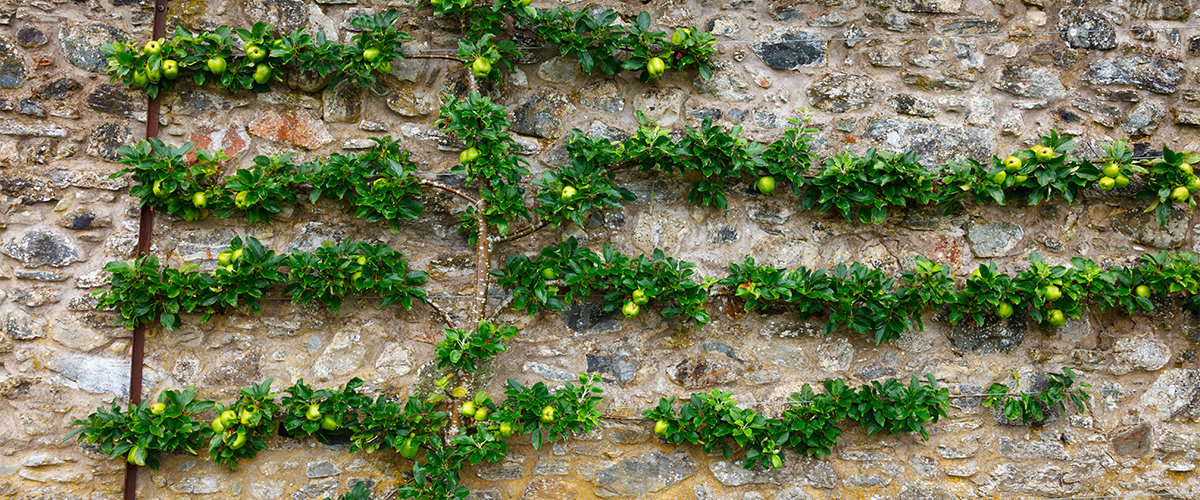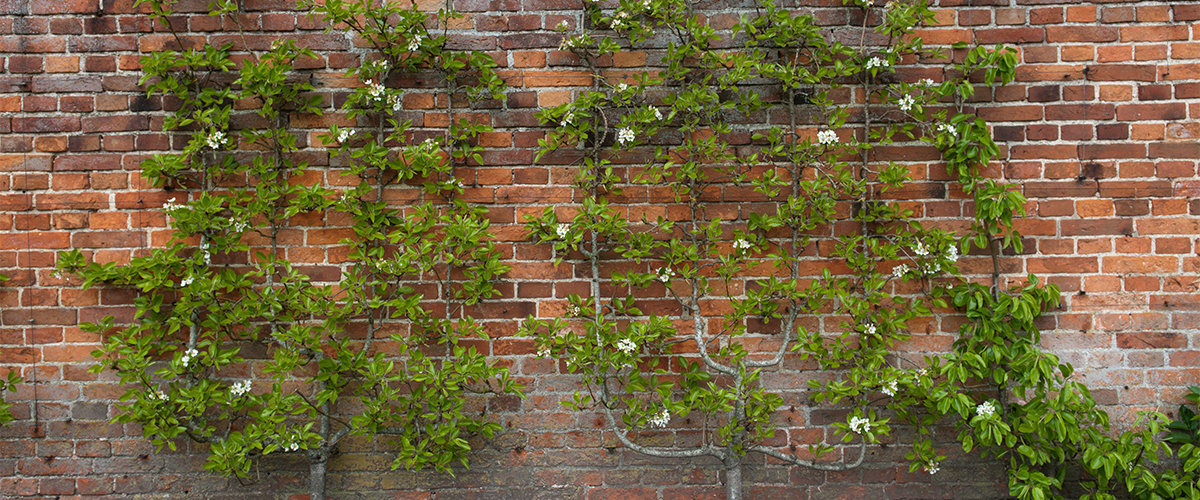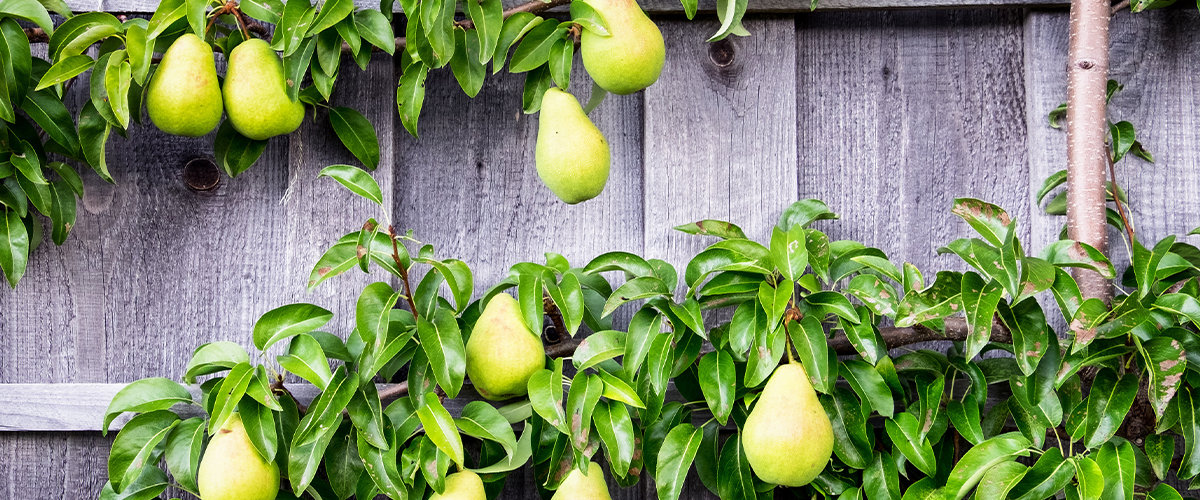
We collect basic website visitor information on this website and store it in cookies. We also utilize Google Analytics to track page view information to assist us in improving our website.
Spring Season starting to book up. Promotions Available for Winter.

When envisioning your ideal backyard and outdoor living space, do you dream of growing an abundance of fresh fruit on your property? Could you see yourself stepping out onto your deck and picking grapes from a vine? Would you enjoy walking your fence line while plucking apples and pears from trees? If so, espalier may be of interest to you!
With espalier, you can make the dream of growing backyard fruit a reality – even if you do not have a lot of space. The best part of espalier is that you don't need significant time or skill to grow trees in two dimensions. Anyone can do it!
Read on below to learn more about:
What espalier is
How espalier differs from topiary
Common espalier designs
Reasons to use espalier in your yard and garden
How to get started with espalier
Espalier (pronounced “es-PAL-yay” or “es-PAL-yer”) is the art and ancient process of controlling the growth of woody plants and shrubs through strategic pruning. Espalier plants are often grown against walls, fences, and trellises though they can also be free-standing.
It is believed that the Romans were the first to utilize espalier, though there is evidence that the Egyptians may have also used the practice. It was also commonly used in the Middle Ages in Europe as a way to grow fruit inside walled gardens and courtyards without utilizing too much space. Today, espalier is most prevalent in Europe but has been incorporated into homes and public gardens worldwide.
It is important to note that espalier is not the same as topiary – even though both art forms result in living sculptures.
The key difference is that espalier focuses on creating specific, two-dimensional designs, while topiary allows for a more comprehensive selection of artistic, three-dimensional shapes. For example, you will typically see five distinct patterns in espalier, while topiary options are seemingly unlimited.
While there are standard espalier designs, some people may choose their own informal variations.
The primary forms are:
Candelabra
Cordon
Palmetto Verrier
Fan
Belgian Fence
This style has a primary, vertical trunk with several horizontal branches extending outward at regular intervals.

From the horizontal branches, vertical branches grow upward. Candelabra espalier has a very fitting name, as it looks exactly like a candelabra once completed.
Cordon espalier is the most traditional espalier form.
It is similar to candelabra because it also has a central trunk with several horizontal branches. However, it does not have the additional vertical branches growing upward on the ends.
Palmetto Verrier espalier also has a central trunk with horizontal branches stretching away from it.

However, this style is unique because the horizontal branches are trained to grow in a U-shaped pattern.
Fan espalier also has a suitable name as trees, shrubs, and vines in this style are pruned and trained to look like a fan.
In this common espalier style, there is a central trunk where branches grow from at a 45-degree angle.
Belgian fence espalier requires three or more trees.
Trees are pruned and trained to form a woven fence that looks like a lattice. The trees on the ends of the lattice are modified to close the design elegantly.
Informal espalier is unique because there are limited rules other than pruning and training the tree, shrub, or vine to lay flat against a wall, fence, or trellis.
Informal espalier is a fun way to experiment with growing in two dimensions without the pressure of conforming to more rigid espalier design styles.
There are many reasons to incorporate espalier into your home garden, including:
Growing fruit trees and vines in smaller spaces
Adding unique visual interest to your outdoor living area
Enhancing the appearance of blank walls and fences
Increasing privacy in a creative way
Below, we dive deeper into the most common reasons people use espalier.
Espalier trees are a great option if you are conscious of space or would like to maximize the number of trees and fruit varieties you can grow.

This is because growing fruit in your yard typically requires a lot of room, particularly if you wish to grow apples, pears, or grapes.
Fruit trees also require adequate airflow to reduce pests and disease, and it does not get airer than espalier. The open design also allows all parts of the vine or tree to get full sun. This full access to airflow and sunlight leads to high fruit production.
As an added benefit, espalier fruit trees and vines are more accessible to harvest than traditionally grown alternatives. In addition, cleaning up fallen fruit and keeping the ground trimmed under an espalier tree is less work than trying to work underneath trees with bushier foliage.
If you have ever seen espalier at someone’s home, in a public garden, or while traveling abroad, you know it is quite intriguing to observe.
The unique, living sculpture(s) of espalier is a great way to elevate your outdoor living space. Adding it to your landscaping is sure to spark many conversations.
Dress up your pergola with a 2-D flowering vine, add a free-standing espalier tree to the centre of your garden, or incorporate espalier accents into your front and back yards. Your neighbours and guests are sure to be impressed!
In addition to growing fruit in small spaces and creating visual interest around your property, espalier can help you cover unsightly walls or bare fences.
For example, add espalier grape vines to the walls of your garden shed, cover up a brick wall, or spruce up your fence with espalier fruit trees.
Experiment with woody plants that produce berries, flowers, or colourful foliage if you would like something different than espalier fruit trees and vines.
Would you like to increase the privacy in your outdoor living space? If so, espalier in the Belgian fence style may be the perfect solution for you!
As you recall, this style utilizes multiple trees in a strategically pruned design to create a lattice fence, making it a visually appealing solution.
Belgian Fence espalier offers partial privacy, perfect for creating private spaces without completely blocking natural light or your view. Use espalier on its own or attach it to new or existing fencing. Opt for flowering or fruiting plants to add colour and home-grown fruit in addition to privacy.
If your interest is piqued by all the options for incorporating espalier into your landscaping, start thinking about where you would like to place your trees or vines. Consider the amount of sun, the type of soil, and the water drainage in those areas.

Next, think about the types of plants that would do well in the sites you have selected. Also, consider your preferences, such as whether you would like fruit, flowers, foliage, or a variety of all three throughout your property.
Once you have your vision in mind, talk to your gardener, landscaper, or arborist about getting started. If you'd like to begin the espalier process by yourself, visit your local garden centre or nursery to purchase your trees, vines, and shrubs.
Experts in gardening and landscaping will know best about which plants will thrive based on your region and the growing conditions on your property, so don't be shy to ask for advice.
Espalier is an ancient art form and process utilized to grow trees, vines, and shrubs in two dimensions.
Plants grown in this style are pruned over several years to create the desired style. While you can opt for an informal approach, the most common espalier styles are candelabra, cordon, palmetto verrier, fan, and Belgian fence.
Espalier is an effective way to grow fruit in small spaces or maximize the number of trees, vines, or shrubs your outdoor space can accommodate. Pruning trees into designs also adds visual interest to your yard. In addition, espalier can be utilized to add hide or enhance the appearance of bare walls or fences. Lastly, it is a natural and creative way to increase privacy.
Getting started with espalier is easy! Simply consider which styles you like, the placement of espalier in your yard, your growing conditions, and the types of plants that would do well in the selected sites. Then, share your vision with your gardener or landscaper, or ask your local nursery for assistance selecting trees, vines, and shrubs that are suitable for espalier.
Are you ready to enhance your property with a stunning new fence or deck? Consider working with Decks by Premier! We are a reliable fence and deck building contractor with 90 years of experience in the Kitchener-Waterloo, Cambridge, and surrounding areas.
We have the technical and design expertise to take your home or income property to the next level. We are also proud to offer an exclusive two-year warranty on all our products and services, giving you complete confidence in your investment.
Our in-house team is ready to start working with you. Reach out to us to speak to a sales representative or schedule a no-obligation, on-site consultation.

